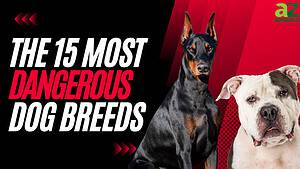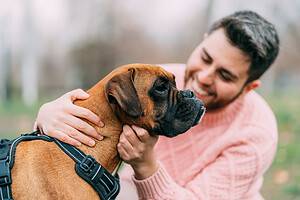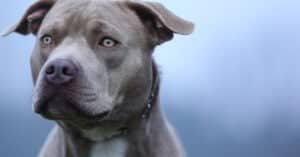Dogs love bones, and what could be more natural than letting Rover gnaw on a bone? Unfortunately, it’s not as simple as that. Wild dogs eat bones, and the marrow is an important nutrient for them, but domesticated dogs are different. All kinds of bone, including steak, pose problems for our pet canine friends. So, are bones safe, and can dogs eat steak bones? Let’s look at the issues.
Is It Safe for My Dogs to Eat Steak Bones?
It depends.
Vets and dog experts disagree on whether it’s safe for dogs to eat steak bones. Dogs enjoy chewing a bone, the saliva they produce helps to protect their teeth, and the marrow is nutritious. However, in general, steak bones do more harm than good, and it’s not safe to give your dog a steak bone. Here’s why.
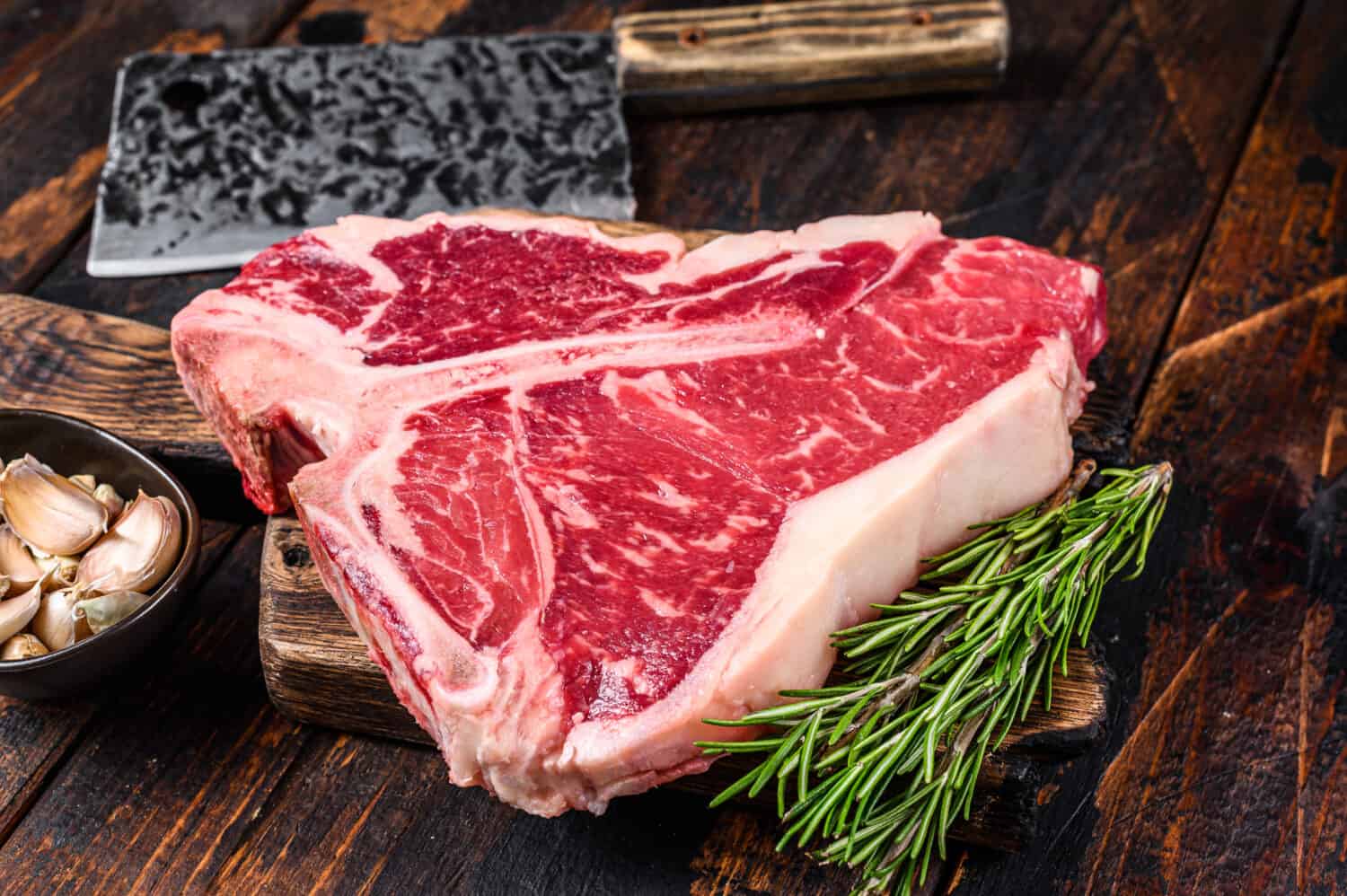
Steak bones do more harm than good, so giving your dog a steak bone is unsafe.
©Mironov Vladimir/Shutterstock.com
Dangers of Steak Bones
Cooked Steak Bones
Cooked steak bones pose a threat to domesticated dogs because their bendy collagen hardens and becomes brittle. This means splinters, shards, and chunks break off in your dog’s mouth and cause damage to their gums, teeth, throat, stomach, and bowel.
Hard, cooked bones are not digestible. They just push their way through your dog’s soft innards, potentially tearing and causing not only painful but expensive damage as they move. Injuries from cooked steak bones include broken teeth and torn bowels, leading to life-threatening sepsis.
Splintered bones can perforate skin on the way down and back up if your dog vomits, which is highly likely if they have an internal bleed.
Raw Steak Bones
Raw steak bones are a safer bet if you want your dog to have one because they are less likely to splinter, but the risk is similar to cooked bones, plus there’s the potential for salmonella and harmful bacteria to make your dog sick. The symptoms of salmonella are vomiting, diarrhea, and dehydration. Even just licking and chewing a bone can transfer bacteria.
Our fluffy friends do not have the same robust digestive systems as their wolf ancestors. There are 10,000 years of human domestication in between them. Our pets just aren’t as tough.
Parasites
Raw steak bones have the potential to infect your dog with parasites. Although pork bones are the main culprit here, raw steak bones can transmit parasites like roundworms.
Toxic Seasoning
The kind of steak bone your dog eyes up is the one left on your plate. Usually, we like to season our steaks, but certain spices and vegetables are dog-toxic. More on that later.
Danger of Choking
Because bones are solid objects, they can block a dog’s throat, even the largest breeds, and cause choking. In the worst instances, this can be fatal.
If a Dog Chokes on Steak Bones, Follow These Steps
Open the dog’s mouth to check for obstructions and sweep a finger around to feel for anything further back. Don’t push it further down. Use tongs or pliers to grab the obstruction.
The next step is the Heimlich maneuver, which uses air in the lungs and stomach to eject a trapped object forcefully. It’s important to perform the maneuver hard and fast.
• Large Dogs
Lie a large dog on its side. Put a fist in the hollow beneath their ribs and push sharply upwards toward their head. Repeat until the blockage is cleared.
• Small Dogs
Lie a small dog on your lap, stomach up, with its head furthest away from you. Put a fist in the hollow beneath the ribcage and quickly push upward toward the head. Repeat.
Choking is immensely stressful for dogs and their owners. Steak bones are a clear choking hazard (as are corn cobs) and are best avoided.
Fat Content
Steak bones full of marrow have high fat content. Pancreatitis is a condition caused by too much fat in the diet. It’s a reoccurring and painful condition that requires expensive treatment each time, and it can also be fatal.
If a dog has suffered from pancreatitis in the past or has gastrointestinal issues, it should never be offered bones.
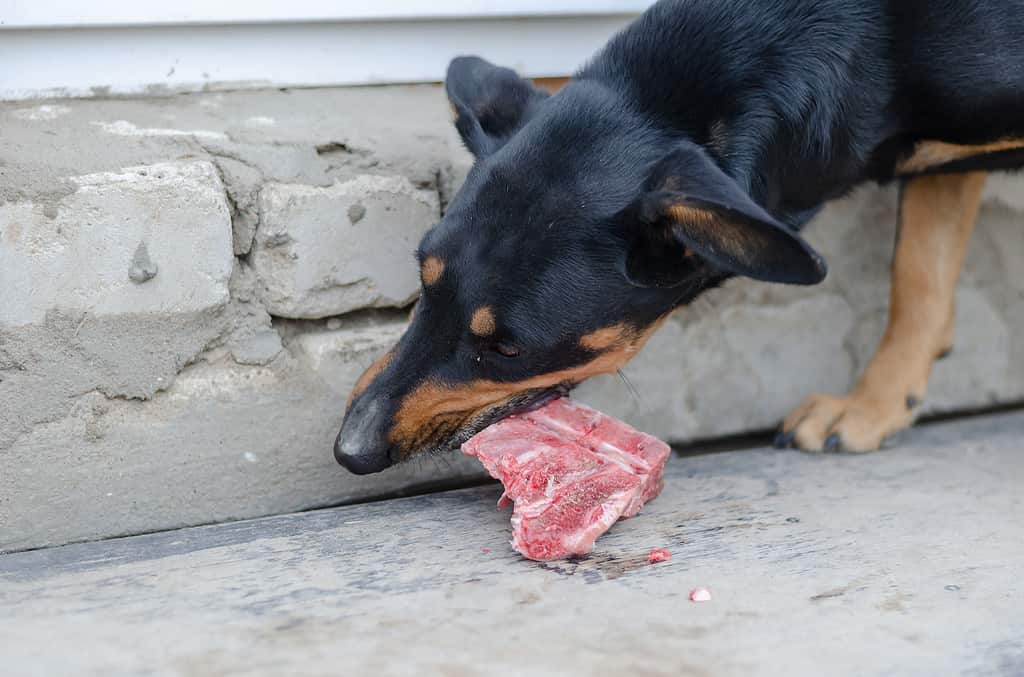
Raw bones are safer than cooked bones since they are less likely to splinter.
©iStock.com/Mikhail Dmitriev
How to Feed a Dog Steak Bones
Most experts recommend domestic dogs are not given steak bones, but if you want to, follow these rules:
- Only offer a dog raw steak bones to minimize splintering risk
- Supervise the dog, and if the bone splinters, remove it immediately.
- If the dog is sensitive around food removing the bone is going to be a problem; do not offer bones at all.
- Take it away after 15 minutes and refrigerate it. Don’t let a dog bury its bone because this leads to bacterial build-up.
- Monitor the dog afterward to ensure they are not struggling with internal damage or broken teeth.
Steak Bones: Nutritional Benefits
Steak bones offer some nutritional benefits, but most vets agree the dangers outweigh any plus points.
- Beef bones are generally larger and harder than animals such as chickens or pigs. This means they are less likely to be swallowed or break into dangerous small pieces.
- Chewing stimulates saliva, which helps break down plaque. This can help prevent gum disease.
Mineral and Vitamins in Bones
- Calcium for strong bones and teeth
- Phosphorus, which supports healthy coats, muscles, and blood
Connective Tissue and Small Parcels of Meat Attached to Bones
- Protein for strong, quickly repairing muscles
- Essential fatty acids are important for healthy skin and coat
- Vitamins A, D, and E for good eyesight, a healthy coat, and bags of energy
Rich Marrow Found Inside Bones
- Copper and iron for healthy blood
- Fat, but it may be too rich for a dog’s digestive system.
My Dog Ate Steak Bones: What Should I Do?
When it comes to a meaty snack, dogs can be sneaky! If Rover doesn’t manage to whisk steak bones from your plate, there’s the kitchen bin and the outside trash to investigate.
If your dog pinched a steak bone, remove it and check its mouth for damage. You’ll need to monitor the dog for a few days afterward to ensure there are no internal injuries.
If no bone is present, but you suspect they’ve eaten one, these are potential signs of distress:
- Thirst
- Gagging
- Coughing
- Hunching
- Vomiting
- Diarrhea
- Lethargy
- Discomfort
If your dog displays any of these symptoms, contact a veterinarian immediately.
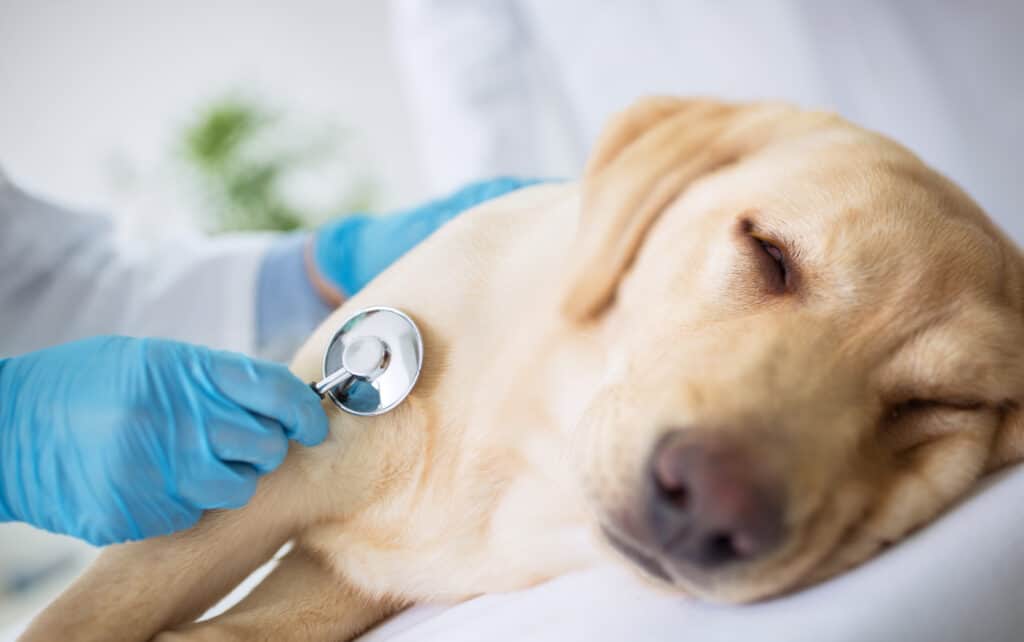
Contact a veterinarian immediately if your dog consumes a bone and displays symptoms such as lethargy, discomfort, gagging, or vomiting.
©didesign021/Shutterstock.com
What Food Is Poisonous for Dogs?
Steak bones and all types of bone pose potential problems for a dog, but these foods are known toxins, and dogs must never consume them.
Garlic and Onions
Dogs cannot digest compounds from the allium family of leeks, onions, garlic, and shallots. Their compounds stick to red blood cells and cause anemia. We often consume steak with onions or garlic sauce, so this is something to watch for.
Grapes
All forms of grapes, including raisins, juice, jelly, and wine, are dog-toxic. Eating grapes can lead to kidney failure.
Chocolate
Theobromine and caffeine in chocolate are stimulants, but dogs can’t process them. It leads to overwhelming pressure on their internal organs and can be fatal.
Macadamia Nuts, Black Walnuts, and Nutmeg
These dog-toxic foods lead to vomiting and collapse. Because they are often ingredients in cakes and biscuits, keeping sweet foods locked away is important to prevent your dog from counter-surfing.
Alcohol
Ethanol can kill dogs, so any form of alcohol, including alcohol-infused sweets, is a danger to your pooch.
Xylitol
Xylitol is an artificial sweetener that’s caused dog fatalities. It’s present in a wide variety of food, from Jell-O to jelly, cakes, biscuits, chewing gum, and toothpaste.
Are Steak Bones Good for Dogs?
Recapping on our question, can dogs eat steak bones? The answer is yes, they can, but they shouldn’t.
Steak bones, especially cooked ones, pose threats that aren’t worth it, no matter how much a dog drools and begs. Bones are not necessary if a dog is offered a complete, nutrient-filled dog food.
Tooth damage, salmonella infections, and the possibility of choking or internal lacerations are so dangerous and expensive that buying your dog a safe toy to chew on is a much better idea.
The photo featured at the top of this post is © iStock.com/vasiliybudarin
Ready to discover the top 10 cutest dog breeds in the entire world?
How about the fastest dogs, the largest dogs and those that are -- quite frankly -- just the kindest dogs on the planet? Each day, AZ Animals sends out lists just like this to our thousands of email subscribers. And the best part? It's FREE. Join today by entering your email below.
Thank you for reading! Have some feedback for us? Contact the AZ Animals editorial team.



